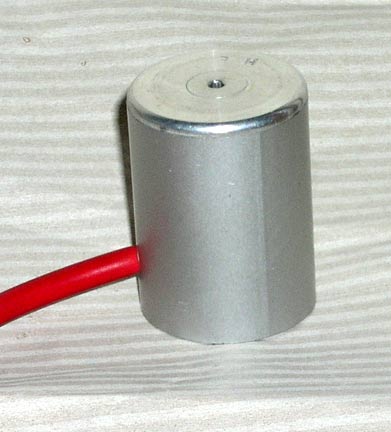10 Gram Pilot Balloon Nozzle U.S. Spec. Helium
This page contains information about the 10 Gram Pilot Balloon
Nozzle (filler).

The standard 10 gram pilot balloon nozzle is pictured above. It is constructed from aluminum tubing and bar stock. It weighs 44 grams without the rubber hose attached. 4 inches of rubber hose weighs 1 gram bringing the total nozzle weight to 45 grams. Outside Diameter of 1.5" and a height of approximately 2".
The nozzle does not have a valve on it, it is operated by a hand valve on the other side of the rubber hose. The user holds the hose about 3 inches from the nozzle about 3 inches off the surface. When the balloon lifts the nozzle so that the hose is straight leading to the nozzle the free lift of the balloon is 45 grams, and the hand valve is closed. The balloon is then sealed and lifted off the nozzle ready for flight.
Nozzles like these are used by the National Weather Service, Bureau of Land Management, and Military Services. They are available on special order from Met Supply houses and Warren Knight Industries. Attention should be paid when ordering (from a meteorological supply house) that the nozzle is produced at a weight of 44 grams and not 39 grams, 41 or 43 grams which would correspond to use with hydrogen gas or non standard ascent rates.
The example above was custom made to National Weather Service specifications by James Long for my use at the World Aerobatic Championships.
10 Gram pilot balloons are also referred to as Ceiling Balloons. Historically daytime cloud heights were measured by timing the balloons ascent into the clouds (night time ceiling was measured by a searchlight and clinometer). Larger 20, 30 and 100 gram balloons were used for wind measurement.
Modern users such as Fire Weather Meteorologists, Hot Air Balloonists, and Aerobatic Aircraft Pilots use 10 gram balloons for winds aloft determination for reasons of portability, economy, lower ascent rate (better profile at lower altitudes).
